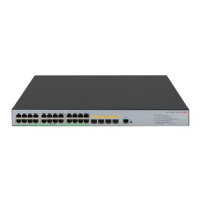251
Ste
Command
Remarks
2. Enter BGP view.
bgp as-number N/A
3. Enter IPv4 MBGP address
family view.
ipv4-family multicast N/A
4. Configure MBGP route
reception filtering policies.
• Filter incoming routes using an
ACL or IP prefix list:
filter-policy { acl-number |
ip-prefix ip-prefix-name }
import
• Reference a routing policy to
routes from an IPv4 MBGP peer
or a peer group:
peer { group-name |
ip-address } route-policy
policy-name import
• Reference an ACL to filter
routing information from an
IPv4 MBGP peer or a peer
group:
peer { group-name |
ip-address } filter-policy
acl-number import
• Reference an AS path list to
filter routing information from
an IPv4 MBGP peer or a peer
group:
peer { group-name |
ip-address } as-path-acl
as-path-acl-number import
• Reference an IP prefix list to
filter routing information from
an IPv4 MBGP peer or a peer
group:
peer { group-name |
ip-address } ip-prefix
ip-prefix-name import
Use at least one command
By default, no inbound route
filtering is configured.
5. Specify the maximum number
of routes that can be received
from an IPv4 MBGP peer or a
peer group.
peer { group-name | ip-address }
route-limit limit [ percentage ]
Optional
The number is unlimited by default.
Configuring MBGP route dampening
By configuring MBGP route dampening, you can suppress unstable routes from being added to the
MBGP routing table or being advertised to MBGP peers.
To configure BGP route dampening:
Ste
Command
Remarks
1. Enter system view.
system-view N/A

